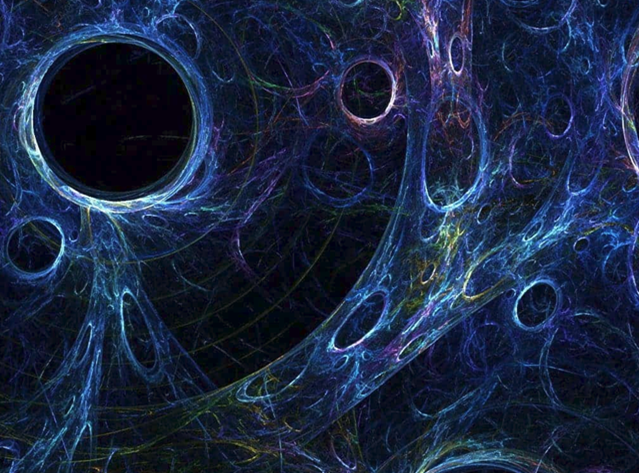
Introduction
How It All Began
One morning as I woke from my sleep, I noticed the light filtering in through the window hit an object that was folded. Upon studying the photon interaction, I noticed that one side was illuminated (our universe) while the bent or folded side was dark (dark matter), and the photons continued to travel past that dark side until they appeared on the wall. So it appeared to me to be serendipitous, and I studied my observation further. As the light dimmed, the lighted side still remained bright, but the dark side of the object became darker, indicating a lack of photon activity in that area.
Theoretical Framework
At the heart of my theory lies a bold proposition: dark matter possesses intrinsic properties that allow it to fold upon itself, creating intricate structures and patterns within the fabric of spacetime. This concept draws inspiration from advanced theoretical frameworks in quantum gravity and particle physics, which seek to unify the fundamental forces of nature and describe the behavior of matter and energy on the smallest and largest scales.
The equation that encapsulates this notion can be expressed as follows:
∇ · D = ρ
Where:
- ∇ represents the gradient operator,
- D denotes the dark matter density,
- ρ signifies the energy density distribution.
This equation serves as a foundational framework for understanding the dynamic interplay between dark matter, gravity, and spacetime curvature—a phenomenon that may give rise to the observed folding and self-interacting behavior of dark matter.
Observational Techniques
To validate this theory and explore its implications, a multifaceted approach combining theoretical innovation with cutting-edge observational techniques is essential. Here are some key avenues for future research:
- Gravitational Lensing Surveys: Conduct comprehensive surveys of gravitational lensing phenomena to map the distribution of dark matter structures in the universe. Look for distinctive patterns and anomalies that may arise from the proposed folding behavior of dark matter.
- Particle Detector Experiments: Collaborate with experimental physicists to design and implement new detection methods capable of identifying signatures of self-interacting dark matter particles. Explore novel detector technologies and data analysis techniques to uncover elusive dark matter
interactions. - Cosmological Simulations: Develop sophisticated computational models to simulate the evolution of dark matter structures within the framework of the proposed folding theory. Use high-performance computing resources to explore the formation and dynamics of folded dark matter
configurations in cosmological contexts.
Interdisciplinary Collaboration
The advancement of this theory relies heavily on interdisciplinary collaboration and cross-fertilization of ideas across various scientific disciplines. By fostering collaboration between theoretical physicists, observational astronomers, particle physicists, and cosmologists, we can harness the collective expertise and insights needed to push the boundaries of dark matter research.
Future Prospects
The pursuit of understanding dark matter’s folding properties represents a frontier of scientific inquiry with profound implications for our understanding of the universe. By elucidating the fundamental nature of dark matter and its interactions with spacetime, we may unlock new avenues for exploring the cosmos, from probing the origins of galactic structures to unraveling the mysteries of cosmic evolution.
As we embark on this journey of discovery, let us embrace the spirit of curiosity, collaboration, and exploration that drives scientific inquiry forward. Together, we can shine a light into the darkest corners of the universe and reveal the hidden secrets that lie beyond.
Conclusion
In conclusion, my new theory on dark matter’s folding behavior offers a fresh perspective on this elusive cosmic phenomenon. By combining theoretical insights with observational rigor and interdisciplinary collaboration, we have the opportunity to expand the frontiers of knowledge and unveil the mysteries of dark matter that have long captivated humanity’s imagination.
As we look to the future, let us remain steadfast in our pursuit of truth and discovery, knowing that each step forward brings us closer to unraveling the enigma of dark matter and unlocking the secrets of the universe.
For further exploration of dark matter and cosmology, consider diving into the following insightful books:
- “Dark Matter and the Dinosaurs: The Astounding Interconnectedness of the Universe” by Lisa Randall
- “Dark Matter and Dark Energy: The Hidden 95% of the Universe (Hot Science)” by Brian Clegg
- “The 4 Percent Universe: Dark Matter, Dark Energy, and the Race to Discover the Rest of Reality” by Richard Panek
Embark on a journey of discovery and enlightenment with these thought-provoking reads, and join the quest to unravel the mysteries of the cosmos.
 |  |  |
This blog article presents my personal theory on dark matter’s folding behavior and is intended to stimulate scientific discourse and exploration within the astrophysics and cosmology communities. Comments are welcomed.



































![[Gigastone] Micro SD Card 32GB 5-Pack, Gaming Plus, MicroSDHC Memory Card for…](https://techcratic.com/wp-content/uploads/2025/07/619ev8iBvzL._AC_SL1000_-360x180.jpg)











































